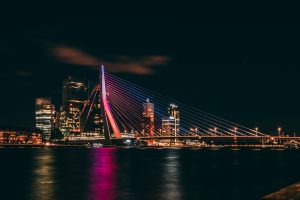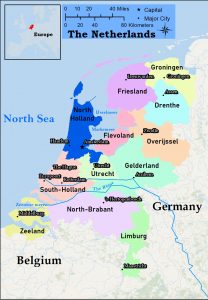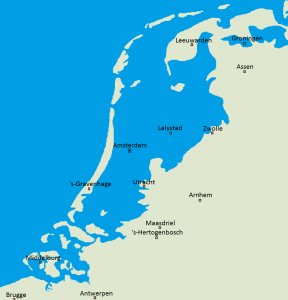51 Europe: Economic Geography I – Netherlands
The Netherlands is one of the smallest countries in the world by area, similar in size to New Jersey. By population, at over one thousand people per square mile, the Netherlands is Europe’s most crowded country and the fifth most crowded in the world, not counting micro-States such as Monaco nor islands nor city-States. Of note, New Jersey is America’s most crowded state.
In the world, there are two dozen tiny countries under one thousand square miles in area, but these are micro-States, city-States, or island countries. Not counting those countries nor other island countries, the Netherlands is the world’s 26th smallest country. Anyway, it is a small place.
By population, the Netherland is a bit over 17 million people, the 68th largest country in the world. So, not tiny, but not a large population.
Gross domestic product for the Netherlands, when adjusted for living standards (PPP – purchasing power parity) and measured by the International Monetary Fund (IMF), places it 28th best in the world. On the Human Development Index (HDI), calculated by the United Nations, the Netherlands rises to be the 10th most developed country in the world.
What about natural resources? In 1959, the vast Groningen gas field was discovered and now accounts for about 25% of the gas reserves of the whole European Union. However, other than this gas resource, the Netherlands has no significant other energy or mineral resources.
Very small area, modest population, almost no raw materials, but very highly established economically and socially. Why? Well, certainly part of the success is due to its relative location in Western Europe, an elite place in the world. Even so, there may be something about the Dutch that has led to their distinctive success.
The answer is that the Netherlands is a very prosperous country due to international trade. Here are a few key reasons why this works so well for the Netherlands. One, as noted above, its relative location is excellent. The country is coastal, giving it access to ocean trade, but also is proximate neighbors to numerous other prosperous European countries. In particular, the Netherlands directly borders Germany, the country with the largest economy in Europe. Germany is the Netherlands’ number one trade partner. Additionally, the Netherlands is across the North Sea from Great Britain, borders Belgium, is a short distance from France. The rest of Europe, a small continent, is not so far away either.

Two, the Netherlands has Europe’s busiest port – Rotterdam. Rotterdam is an excellent break-of-bulk location, where ocean-going ships can dock and offload their cargoes onto smaller vessels on the Rhine River. Yes, Rotterdam is the mouth of the Rhine River, its exit point into the North Sea and thus the Atlantic Ocean.
Products shipped from anywhere in the world may be brought to Rotterdam and then down the Rhine River into Germany to cities such as Bonn and Cologne. In addition, the Rhine-Main-Danube Canal that connected these three rivers in 1992 allows cargo to travel much farther, in fact on the Danube all the way to the Black Sea. The Danube River at times is an international border, while at other times crosses such borders; distinctively, it does so more than any other river in the world. This international access, including passing through national capitals (Bratislava, Vienna, Belgrade, Budapest), is a tremendous boon for trade in either direction. According to NationMaster, the Netherlands has the 8thdensest road system in the world, thereby offering an alternative means of distribution to or from Rotterdam’s port.
Three, the Dutch have an extensive history of international trade. Certainly, we recognize that the British, the French, and the Spanish had noteworthy explorations, conquests, and colonies across the world. Often though, we forget that the Dutch (and the Portuguese) also had similar broad geographic histories. The trade routes and relationships established through a few centuries of international activity have been maintained to the present day.
Thus, the Netherlands has trade connections throughout the world, bringing a variety to goods into the country as imports, but some pass through the country on the Rhine system or through the Netherlands road and rail system. A variety of products are added to these imports for distribution throughout Europe. All of this then works in the opposite direction for sending products out from Rotterdam to overseas markets.
How well do the Dutch do this? According to the Observatory for Economic Complexity (OEC), “The economy of the Netherlands has an Economic Complexity Index (ECI) of 1.3 making it the 18th most complex country. The Netherlands exports 419 products with revealed comparative advantage (meaning that its share of global exports is larger than what would be expected from the size of its export economy and from the size of a product’s global market).”1In other words, the Netherlands does a great job at creating and enhancing products for export.
For a diagram from Statistics Netherlands (CBS) showing a complex pattern of import, export, and transit-through trade flows, go to this website.
Four, maintenance of all these trade relationships all across the world and with all sorts of countries and cultures comes naturally to the Dutch and their way of life. One key word describing the Dutch way of life is gedogen. This word means “tolerance” but is best construed to mean “active tolerance.” The Dutch culture does not simply look the other way at behaviors that might be considered different or odd in other cultures, but actively allows and accepts differences. Arguably, this permits the Dutch to get along with anyone anywhere, an approach that naturally would favor cooperative trade around the world. Probably the most noticed examples of gedogen or active tolerance in the Netherlands is the acknowledgement that while prostitution and drug use might be considered problems and by some might be considered immoral, neither prostitution nor drug use will disappear, so it is better to create a managed, regulated context where these activities can persist in a relatively safe manner.
Overall, how well does the Netherlands do in international trade? In exports it ranks #5 in the world, in imports #8 in world, with about ¾ of these flows happening in Europe. For an excellent visual depiction of export totals from around the world, go to https://www.visualcapitalist.com/mapped-worlds-largest-exporters-in-2018/
The country is #2 in world in agricultural exports, only behind the United States, a vastly larger country. It is #1 in the world in the export of flowers and flower bulbs, but #2 in the world in exported tomatoes. The port of Rotterdam physically is the largest in the world. All of this is rather amazing, given the country’s rather modest size both in population and in area.
Did You Know?
Don’t forget that before it was New York, it was New Amsterdam.
There are two common errors that people make about the Netherlands. First, the ethnic group of the Netherlands is the Dutch. The people of Germany call themselves “Deutsch.” These two peoples – the Dutch and the Deutsch – are not the same.

Second, Holland is only a part of the Netherlands, but not the whole country. There are twelve provinces of the Netherlands (the name literally means “low lands”) = North Holland, South Holland, Zeeland, Friesland, and eight more. Given that Holland is the most famous area of the Netherlands, some Dutch say that Holland is the brand name for the Netherlands.

Public Domain.
Not necessarily related to trade, the other famous feature of the Netherlands is its amount of land that should be under water. The Dutch have done an amazing job of engineering to reclaim land from the sea, holding out the water with dams and dikes. This map shows where the sea would be without the engineering of recovered land.
This chapter is dedicated to my friend and academic exchange colleague Dick Van Schaik of Harderwijk, Netherlands, who died unexpectedly in 2017.


